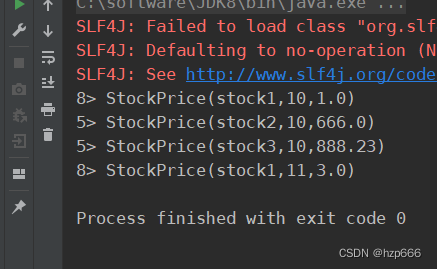-
Flink学习20:算子介绍reduce
1.reduce简介
按照指定的方式,把每个元素进行累计执行。比如实现累加计算

示例:
import keyByNameTest.StockPrice
import org.apache.flink.api.scala.createTypeInformation
import org.apache.flink.streaming.api.scala.StreamExecutionEnvironmentobject reduceTest {
//defined the dataSource's data type
case class StockPrice(stockId:String, timestamp: Long, price:Double)def main(args: Array[String]): Unit = {
//create env
val env = StreamExecutionEnvironment.getExecutionEnvironment//create ds
val pricesList = List(StockPrice("stock1", 10, 1), StockPrice("stock1", 11, 2), StockPrice("stock2", 10, 666), StockPrice("stock3", 10, 888.23))
val ds = env.fromCollection(pricesList)
//transformation
//update the stock's new time, and accumulate the price
val reducedDs = ds.keyBy(0).reduce((t1, t2) => StockPrice(t1.stockId, t2.timestamp, t1.price + t2.price))reducedDs.print()
env.execute()
}
}
输出结果:
自定义reduce func
核心步骤:
1.继承 ReduceFunction 类
2.重写reduce 方法
示例:
import org.apache.flink.api.common.functions.ReduceFunction import org.apache.flink.api.scala.createTypeInformation import org.apache.flink.streaming.api.scala.StreamExecutionEnvironment object myReduceTest { //defined the dataSource's data type case class StockPrice(stockId:String, timestamp: Long, price:Double) //define my reduce func update the stock's new time, and accumulate the price class MyReduceFunc extends ReduceFunction[StockPrice] { override def reduce(t: StockPrice, t1: StockPrice): StockPrice = { //update the stock's new time, and accumulate the price StockPrice(t.stockId, t1.timestamp, t.price + t1.price) } } def main(args: Array[String]): Unit = { //create env val env = StreamExecutionEnvironment.getExecutionEnvironment //create ds val pricesList = List(StockPrice("stock1", 10, 1), StockPrice("stock1", 11, 2), StockPrice("stock2", 10, 666), StockPrice("stock3", 10, 888.23)) val ds = env.fromCollection(pricesList) //transformation val keyByedDs = ds.keyBy(0) //use my reduce func val myReducedDs = keyByedDs.reduce(new MyReduceFunc) myReducedDs.print() env.execute() } }输出结果:

-
相关阅读:
聊聊基于Alink库的推荐系统
设计模式之单例模式
Python 多进程编程《*》:shared_memory 模块
Vue系列之指令
Jmeter扩展---自定义取样器
面试官:并发编程实战会吗?(线程控制操作详解)
如何看待现在的网络安全行业?
即时通讯开发移动端弱网络优化方法总结
java迷宫寻找最短路径
vue-cli 输出的模板 html 文件使用条件语句
- 原文地址:https://blog.csdn.net/hzp666/article/details/126269374
